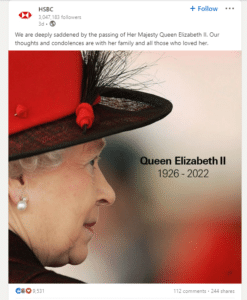Crisis Management for B2B Social Media
‘Crisis’ is a scary word, literally meaning ‘a time of intense difficulty or danger’. In business terms, crisis means the threat of long-term damage to your company’s reputation, its operations, and its future success. However you look at it, it indicates urgency, disruption and unrest.
In social media, there are different levels to a crisis. If we take B2B companies for example, there can be various factors that would lead to such an event worthy of that description – some within the organisation, others that are external and out of anyone’s control – but they will likely affect everyone. For the purpose of this article and recent events that have rocked the world, we’ll look at the latter today.
The human approach is usually the best option in a time of crisis. Of course you need to have processes, but don’t let these dilute the sincerity of the message you’re trying to portray. Respond appropriately and quickly – but if you have nothing to add to a conversation, sometimes simply saying nothing is enough and instead pause activity until some level of normality resumes.
It’s important to read the room. Put yourself in the shoes of your audience – do they care what you have to say about your product or service at a time of national mourning? No offense, but they probably don’t. In the middle of a worldwide epidemic, does anyone really want to be targeted with a contradictory LinkedIn ad? Again, probably not.
It’s natural to want to have your say, especially if other brands are posting, but get it wrong and you’re likely to receive backlash for your insensitive timing. Social media is a double-edged sword when it comes to crisis communications. Sometimes, it can be detrimental to a company’s reputation – just one ill-scheduled tweet can cancel a brand these days; whereas used sensitively, it can also help aid conversation and inform people with vital information. Don’t jump on any bandwagons, but stay grounded and relevant. People can see through ingenuine actions, and any attempts to hijack a tense topic will spectacularly backfire.
We recommend having a Crisis Communication Plan prepared so that when things go sideways, you’re already on the front foot. It could be an extension of an existing PR one, but it deserves enough real estate to warrant its own. After all, what’s that old saying about failing to prepare?
Firstly, identify the stakeholders who will form a crisis committee – but bear in mind that other saying about ‘too many cooks’. You want enough people to get a rounded opinion on what to do, but not so many that you’ll get conflicting ideas.
The next step is to create an escalation policy. Run through different scenarios with the team from past events and potential future ones. How will you navigate the brand through this on your social media channels? What is your go-to position in a crisis, is it to put a message out straight away, or go silent? Either way, you need to make a decision and stick with it – speed is of the essence when it comes to managing social media in a crisis.
If you do choose to post during a crisis, we recommend keeping it simple and tasteful. Here are a couple of great examples of brands who posted following the sad passing of Her Majesty The Queen:
HSBC chose an image of the Queen, which subtly tied with their brand colours. Again, they kept it simple, both in the image and the copy. Be very mindful that your messaging isn’t pushing your brand – it’s not an opportunity to increase brand awareness, it’s one to demonstrate the morals and ethics of your company, standing with your community at this difficult time.
Microsoft’s post was a little more personal, saying “we will miss her greatly”.
As an agency, we need to communicate with multiple stakeholders and provide best practice guidance for any given situation. The principles are often the same. You should always know who the key decision-maker is and if they are not available, who is the next person of authority. If there’s a nationwide (or worldwide) crisis and you can’t get the answers or direction you need from the relevant person, the safest thing to do is ‘go dark’ (pause any outgoing messaging). Postpone any scheduled content (if you’re using a scheduling tool, like Sprout Social, ensure you have gone through and paused anything in the calendar) until you can get clarity – it’s better to be safe than sorry (another cliché for you, but still true).
It’s not just your business’ social profiles to think about, you also need to set clear expectations for your staff. Inform your employees of the company’s response to a crisis and encourage them to be mindful of their own use of social media. Refer to your social policy (perhaps take this as an opportunity to update it) to show your expectation of sharing opinions publicly at such time and the repercussions it could have on the business if someone was to voice a controversial or insensitive message at a time of crisis.
If you want more advice on how to handle a crisis, or on any other aspect of managing your B2B social media, then get in touch and we’d be happy to help.




